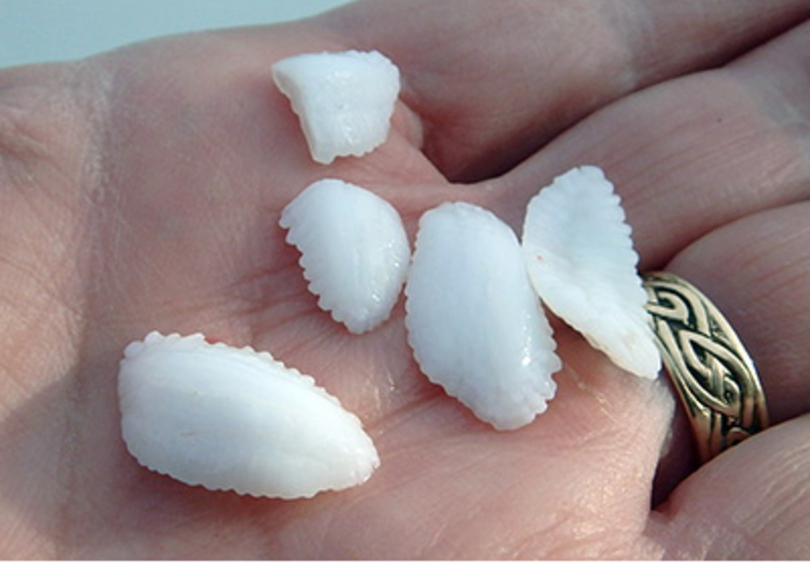SUNY-ESF professor works to find the age of cod in the Baltic Sea

Courtesy of Karin Limburg
Limburg studies cod otoliths, which are calcified structures that grow in the inner ears of most fish species. Otoliths can allow scientists to determine the age of a fish.
Professor Karin Limburg of SUNY-ESF recently became involved with a research project in an effort to determine the age of cod in the Baltic Sea — something that can have a considerable impact on the fishing industry.
The ultimate goal of Tagging Baltic Sea Cod (TABASCO), Limburg said, is to discover a better way of aging these fish so the fishing industry can receive more reliable information for fishery management.
“This problem could vary year to year,” said Limburg, who is a professor of environmental and forest biology at the State University of New York College of Environmental Science and Forestry. “It is extremely bad at the moment, but could improve upon the coming together of factors that improve cod health, allowing them to grow stronger.”
TABASCO is a new endeavor expected to span over the course of four years, Limburg said. Limburg’s role is to help determine the age of the cod.
The professor’s involvement in the project stems from her role as a visiting professor in the Department of Aquatic Resources at the Swedish University of Agricultural Sciences (SLU). She will advise graduate students working on the project in Sweden, she said.
Limburg said it is “vital” to be able to age cod in order to manage them sustainably. She called cod fisheries “economic engines.”
“Cod is an iconic species,” she said. “They used to be one of the most abundant large fishes in the Atlantic, but they became heavily overfished.”
The fact that it is difficult to determine the age of cod in the Baltic Sea has a direct economic impact on the fishing industry, Limburg said. Age determination contributes to the development of stock assessment models, which are necessary to set sustainable fishing quotas. The Marine Stewardship Council (MSC) sets standards for sustainable fishing.
MSC clients receive a certification known as an ecolabel, which means those products are more sustainable, Limburg said. Retailers including Wal-Mart and Whole Foods Market purchase MSC-certified products, which consumers are willing to pay more for, she said.
MSC has pulled its certifications of cod in the areas surrounding the Baltic Sea due to the lack of reliable information about the fish, Limburg said.
The difficulty in aging the cod stems from a condition in the Baltic Sea called hypoxia, Limburg said. Hypoxia is an oxygen deficiency in the water and is the result of industrial and agricultural pollution from surrounding countries. Global climate change also contributes to hypoxia, as rising water temperatures cause the water to hold less oxygen, she added.
Limburg compares life for fish in hypoxic waters to being cooped up in a stuffy room, making it difficult to breathe.
Cod tend to spawn in areas of the Baltic Sea that are hypoxic, Limburg said, because those are the only areas with enough salinity — or the amount of salt dissolved in water — to keep their eggs buoyant. If the salinity requirement is not met, eggs will sink to the bottom of the sea and perish, Limburg said.
Limburg studies the chemical composition and trace elements of otoliths, which are calcified structures that grow in the inner ears of most fish species. Over time, otoliths develop growth rings, which allow scientists to determine the age of the fish, like tree rings help scientists determine the age of trees, Limburg said. Otoliths in Baltic Sea cod have become increasingly difficult to read as a result of the hypoxia, she added.
Cod are also facing starvation as their prey have moved elsewhere, Limburg said, and these combined stresses make them more susceptible to diseases and parasites, affecting their growth.
“My expertise can be used to help understand if some of the chemical properties (of otoliths) can help us with age determination,” she said. “Even though we cannot see the growth bands clearly, chemistry still has a seasonal pattern.”
Other researchers involved in TABASCO are tagging individual cod and analyzing data from the tags to find information about the environment the cod live in, including temperature, salinity and depth. This will be compared to the information that Limburg and her collaborators find in the otoliths.




